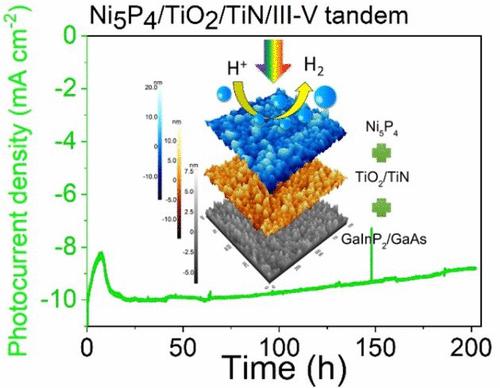当前位置:
X-MOL 学术
›
ACS Energy Lett.
›
论文详情
Our official English website, www.x-mol.net, welcomes your
feedback! (Note: you will need to create a separate account there.)
TiO2/TiN Interface Enables Integration of Ni5P4 Electrocatalyst with a III–V Tandem Photoabsorber for Stable Unassisted Solar-Driven Water Splitting
ACS Energy Letters ( IF 19.3 ) Pub Date : 2024-02-02 , DOI: 10.1021/acsenergylett.3c02606 Shinjae Hwang 1 , Hengfei Gu 1 , James L. Young 2 , Myles A. Steiner 2 , Anders B. Laursen 1 , Ryan A. Crichton 1 , Yao-Wen Yeh 3 , Philip E. Batson 3 , Leonard C. Feldman 3, 4 , Mengjun Li 1 , Keenan Wyatt 2 , Ahmad Safari 4 , Todd G. Deutsch 2 , Eric Garfunkel 1 , G. Charles Dismukes 1, 5
ACS Energy Letters ( IF 19.3 ) Pub Date : 2024-02-02 , DOI: 10.1021/acsenergylett.3c02606 Shinjae Hwang 1 , Hengfei Gu 1 , James L. Young 2 , Myles A. Steiner 2 , Anders B. Laursen 1 , Ryan A. Crichton 1 , Yao-Wen Yeh 3 , Philip E. Batson 3 , Leonard C. Feldman 3, 4 , Mengjun Li 1 , Keenan Wyatt 2 , Ahmad Safari 4 , Todd G. Deutsch 2 , Eric Garfunkel 1 , G. Charles Dismukes 1, 5
Affiliation

|
H2 production by direct photoelectrochemical (PEC) water splitting has remained unachievable commercially, mainly due to rapid failure at the interface between the photoabsorber(s) and catalyst(s). PEC devices made from multijunction III–V semiconductors with platinum group metal (PGM) catalysts have yielded impressive initial solar-to-H2 (STH) efficiency >19%, which rapidly corrodes in aqueous electrolytes. Here, TiO2/TiN layers were fused to create a bifunctional interface between a GaInP2/GaAs III–V tandem photoabsorber and a polycrystalline Ni5P4 HER catalyst. The TiO2 serves as a conducting corrosion barrier, while a thin layer of much denser TiN (1 nm) blocks interlayer diffusion during fabrication. This strategy allows the elevated temperatures needed to crystallize the Ni5P4 nanoparticles and fuse to the TiO2/TiN junction to achieve minimal optical loss without damaging the sensitive photoasbsorber. The resulting photocathode exhibits an initial STH efficiency of 11.4%–13.2% in sodium phosphate electrolyte at neutral pH 7. It operated continuously for over 200 h without failure above 10% STH efficiency, exceeding all previous benchmarks. The earth-abundant Ni5P4 catalyst replaces costly PGM catalysts at comparable HER activity in neutral, acidic, or basic pH electrolytes.
中文翻译:

TiO2/TiN 界面可将 Ni5P4 电催化剂与 III-V 串联光吸收剂集成,实现稳定的无辅助太阳能驱动水分解
通过直接光电化学(PEC)水分解生产H 2在商业上仍然无法实现,这主要是由于光吸收剂和催化剂之间的界面处的快速失效。由多结 III-V 族半导体和铂族金属 (PGM) 催化剂制成的 PEC 装置已产生令人印象深刻的初始太阳能转化为 H 2 (STH) 的效率 >19%,但在水性电解质中会迅速腐蚀。此处,TiO 2 /TiN 层融合,在 GaInP 2 /GaAs III-V 串联光吸收剂和多晶 Ni 5 P 4 HER 催化剂之间形成双功能界面。TiO 2充当传导腐蚀屏障,而密度大得多的TiN (1 nm) 薄层则在制造过程中阻止层间扩散。该策略允许使 Ni 5 P 4纳米颗粒结晶并熔合到 TiO 2 /TiN 结所需的高温,以实现最小的光学损失,而不损坏敏感的光吸收器。由此产生的光电阴极在中性 pH 值 7 的磷酸钠电解质中表现出 11.4%–13.2% 的初始 STH 效率。它连续运行超过 200 小时,没有出现超过 10% STH 效率的故障,超过了之前的所有基准。地球上储量丰富的 Ni 5 P 4催化剂取代了昂贵的 PGM 催化剂,在中性、酸性或碱性 pH 电解质中具有相当的 HER 活性。
更新日期:2024-02-02
中文翻译:

TiO2/TiN 界面可将 Ni5P4 电催化剂与 III-V 串联光吸收剂集成,实现稳定的无辅助太阳能驱动水分解
通过直接光电化学(PEC)水分解生产H 2在商业上仍然无法实现,这主要是由于光吸收剂和催化剂之间的界面处的快速失效。由多结 III-V 族半导体和铂族金属 (PGM) 催化剂制成的 PEC 装置已产生令人印象深刻的初始太阳能转化为 H 2 (STH) 的效率 >19%,但在水性电解质中会迅速腐蚀。此处,TiO 2 /TiN 层融合,在 GaInP 2 /GaAs III-V 串联光吸收剂和多晶 Ni 5 P 4 HER 催化剂之间形成双功能界面。TiO 2充当传导腐蚀屏障,而密度大得多的TiN (1 nm) 薄层则在制造过程中阻止层间扩散。该策略允许使 Ni 5 P 4纳米颗粒结晶并熔合到 TiO 2 /TiN 结所需的高温,以实现最小的光学损失,而不损坏敏感的光吸收器。由此产生的光电阴极在中性 pH 值 7 的磷酸钠电解质中表现出 11.4%–13.2% 的初始 STH 效率。它连续运行超过 200 小时,没有出现超过 10% STH 效率的故障,超过了之前的所有基准。地球上储量丰富的 Ni 5 P 4催化剂取代了昂贵的 PGM 催化剂,在中性、酸性或碱性 pH 电解质中具有相当的 HER 活性。











































 京公网安备 11010802027423号
京公网安备 11010802027423号